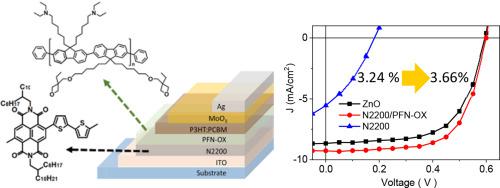Organic Electronics ( IF 2.7 ) Pub Date : 2020-11-26 , DOI: 10.1016/j.orgel.2020.106008 Fang-Chi Hsu , Yu-An Lin , Chi-Ping Li

|
Redissolusion of an organic film by the subsequent processing solvent is a critical issue for the fabrication of organic multilayer structures and this can limit the advanced development of organic devices for flexible/stretchable application. In this study, we present a simple, doable, and straightforward approach to overcome this problem through introducing a solvent barrier. As a demonstration, we have successfully deposited an organic photoactive material on top of an organic electron transport layer (ETL) by pre-depositing a solvent barrier layer on the ETL for fabricating inverted polymer solar cells (PSCs). Water-/alcohol-soluble and thermally cross-linkable poly[9,9-bis(6’-(N,N-diethylamino)propyl)-fluorene-alt-9,9-bis-(3-ethyl(oxetane-3-ethyloxy)-hexyl)-fluorene] (PFN-OX) is selected as the solvent barrier material. PSCs fabricated with organic-ETL/PFN-OX bilayer show improved performance in comparison with those using conventional ZnO as ETL due to the enhanced interface compatibility as well as improved charge extraction, hole blocking, and interfacial recombination properties. In addition, those devices also exhibit longer lifetime and better light-soaking stability. Therefore, the approach of introducing solvent barrier is facile to stack organic films of similar solvent preference together and the resulting structure carries enhanced interfacial electrical properties, which can have positive effects on the device performance. We believe that our proposed idea is very useful and can advance the development of flexible/stretchable devices to be applied in wearable technology.
中文翻译:

使用共轭聚合物作为有机电子传输层的溶剂阻挡层的稳定聚合物太阳能电池
有机膜被后续的处理溶剂再溶解对于有机多层结构的制造来说是一个关键问题,并且这可能会限制用于柔性/可拉伸应用的有机器件的高级开发。在这项研究中,我们提出了一种简单,可行和直接的方法,通过引入溶剂隔离层来克服此问题。作为演示,我们已经通过在ETL上预沉积溶剂阻挡层来制造倒置聚合物太阳能电池(PSC),成功地在有机电子传输层(ETL)上沉积了有机光敏材料。水/醇溶和可热交联的聚[9,9-双(6'-(N,N-二乙氨基)丙基)-芴-alt-9,9-双-(3-乙基(氧杂环丁烷-3选择[-乙氧基)-己基)-芴](PFN-OX)作为溶剂阻隔材料。与使用常规ZnO作为ETL的PSC相比,用有机ETL / PFN-OX双层制造的PSC由于界面相容性增强以及电荷提取,空穴阻塞和界面重组等特性而得到了改进。此外,这些器件还具有更长的使用寿命和更好的透光稳定性。因此,引入溶剂阻挡层的方法易于将具有相似溶剂偏好的有机膜堆叠在一起,并且所得结构具有增强的界面电性能,这可以对器件性能产生积极影响。我们认为,我们提出的想法非常有用,并且可以促进可穿戴技术中应用的柔性/可拉伸设备的开发。











































 京公网安备 11010802027423号
京公网安备 11010802027423号